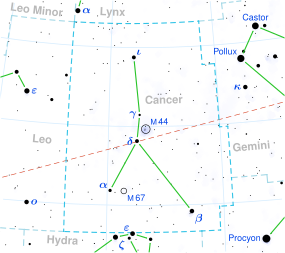Location of DX Cancri in the constellation Cancer | |
| Observation data Epoch J2000 Equinox J2000 | |
|---|---|
| Constellation | Cancer |
| Right ascension | 08h 29m 49.35279s [1] |
| Declination | +26° 46′ 33.6241″ [1] |
| Apparent magnitude (V) | 14.81 [2] |
| Characteristics | |
| Spectral type | M6.5V [3] |
| Apparent magnitude (J) | 8.2 [2] |
| U−B color index | +2.11 [4] |
| B−V color index | +2.08 [4] |
| Variable type | Flare star [2] |
| Astrometry | |
| Radial velocity (Rv) | +9.0 [5] km/s |
| Proper motion (μ) | RA: −1,113.694 mas/yr [1] Dec.: −612.191 mas/yr [1] |
| Parallax (π) | 279.2496±0.0637 mas [1] |
| Distance | 11.680 ± 0.003 ly (3.5810 ± 0.0008 pc) |
| Absolute magnitude (MV) | 16.98 [6] |
| Details | |
| Mass | 0.106±0.009 [7] M☉ |
| Radius | 0.1235±0.0006 [7] R☉ |
| Luminosity | 0.00073±0.000007 [7] L☉ |
| Surface gravity (log g) | ~5 [7] cgs |
| Temperature | 2,840 [8] K |
| Rotation | 0.46 days [9] |
| Rotational velocity (v sin i) | 11.0 [10] km/s |
| Age | 200 [11] Myr |
| Other designations | |
| G 051-015, GCTP 2016.01, GJ 1111, LHS 248 [2] | |
| Database references | |
| SIMBAD | data |
DX Cancri is a red dwarf star in the northern zodiac constellation of Cancer. It is the 18th closest star (or star system) to the Sun, at a distance of 11.680 light-years (3.581 parsecs ) as determined by its parallax. It is also the nearest star in Cancer. [13] Despite this, the star has less than 1% of the Sun's luminosity [7] and, with an apparent visual magnitude of 14.81, [2] is far too faint to be seen with the naked eye. Visually viewing this star requires a telescope with a minimum aperture of 16 in (41 cm). [14]
Contents
In 1981, Bjørn Ragnvald Pettersen discovered that the star, then called G 51-15, is a variable star. [15] It was given its variable star designation, DX Cancri, in 1985. [16] It is a flare star that has unpredictable, intermittent increases in brightness by up to a factor of five.
The star has a stellar classification of M6.5V, [3] identifying it as a type of main sequence star known as a red dwarf. Such stars are characterized by their high abundance in the universe, low mass, radius, faint brightness and reddish color. [17] It has about 10% of the mass of the Sun, and 12% of the Sun's radius. [7] The outer envelope of the star has an effective temperature of 2,840 K. [8]
It is a proposed member of the Castor Moving Group of stars that share a common trajectory through space. This group has an estimated age of 200 million years. [18]

